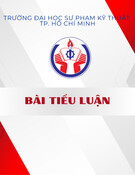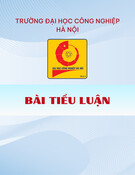
1
MINISTRY OF EDUCATION
AND TRAINING
VIETNAM ACADEMY OF
SCIENCE AND TECHNOLOGY
GRADUATE UNIVERSITY OF SCIENCE AND TECHNOLOGY
-----------------------------
NGO DUY TAN
ATTITUDE ESTIMATION FOR SMALL EARTH
OBSERVATION SATELLITE BY FUSION OF
GYROSCOPE SENSOR AND STAR TRACKER
Major: Control and Automation Engineering
Code: 62 52 02 16
SUMMARY OF DOCTORAL THESIS
ON CONTROL AND AUTOMATION ENGINEERING
Hanoi – 2018

2
The thesis was completed at Graduate University of Science and
Technology, Vietnam Academy of Science and Technology.
Supervisor 1: Assoc.Prof.Dr. Thai Quang Vinh
Supervisor 2: Dr. Bui Trong Tuyen
Reviewer 1: …
Reviewer 2: …
Reviewer 3: ….
The thesis is defended to the thesis committee for the Doctoral Degree,
at Graduate University of Science and Technology –
Vietnam Academy of Science and Technology,
on.....Date...Month...Year 2018.
Hardcopy of the thesis can be found at:
- Library of Graduate University of Science and Technology
- National Library of Vietnam

3
LIST OF AUTHOR’S WORKS
1. Dự đoán tư thế vệ tinh quan sát Trái đất bằng phương pháp hợp
nhất dữ liệu đa cảm biến, Kỷ yếu Hội thảo khoa học “Nghiên cứu
phát triển và ứng dụng công nghệ vũ trụ - 2011”, Viện Công nghệ
vũ trụ, 2011.
2. Hợp nhất dữ liệu cảm biến tốc độ quay và cảm biến sao để dự đoán
tư thế vệ tinh nhỏ, Kỷ yếu Hội thảo quốc gia lần thứ XV: Một số
vấn đề chọn lọc của Công nghệ thông tin và truyền thông- Hà Nội,
03-04/12/2012
3. Xác định tư thế bằng bộ kết hợp cảm biến sao và con quay hồi
chuyển trên vệ tinh VNREDSat-1, Kỷ yếu Hội thảo Công nghệ vũ
trụ và Ứng dụng – Hà Nội, 19/12/2014
4. Hiệu chỉnh quỹ đạo cho vệ tinh nhỏ quan sát Trái đất trên quỹ đạo
đồng bộ Mặt trời, Kỷ yếu Hội thảo Công nghệ vũ trụ và Ứng dụng
– Hà Nội, 19/12/2014.
5. Small satellite attitude determination by gyroscope and star
tracker fusion, International Conference on Information and
Convergence Technology for Smart Society - Ho Chi Minh, 1/2016
6. A New Approach for Small Satellite Gyroscope and Star Tracker
Fusion, Indian Journal of Science and Technology, Volume 9,
Issue 17, 5/2016 (tạp chí thuộc danh mục SCOPUS).
7. Xác định quỹ đạo vệ tinh viễn thám phù hợp với điều kiện Việt Nam,
Tạp chí Khoa học đo đạc và bản đồ, số 34-12/2017.
8. Proposed design of a fault-tolerance attitude estimator for small
earth observation satellite, International Journal of Mechanical
Engineering & Technology (IJMET), Volume 9, Issue 1, 1/2018
(tạp chí thuộc danh mục SCOPUS).
9. Study on the needs and proposal for high and very high resolution
satellite remote sensing systems in Viet Nam, International Journal
of Civil Engineering & Technology (IJCIET), Volume 9, Issue 1,
1/2018 (tạp chí thuộc danh mục SCOPUS).

4
FOREWORD
Data from satellite attitude sensors (orientation sensors, angular
rate sensors) needs to be merged together to produce a reliable output
provided to the controller. This is the key task. of the satellite attitude
estimator.
Some challenges and contraints are:
- Contraint in power supply.
- Processing capability: on-board tasks are mainly implemented on
FPGA (Field Gate programmable array) or SoC (System on Chip).
- Impacts by space environment and radiation: these are typical
charateristcs which determine the design and on-board part
selections.
- Ground-satellite communication period: limited duration for
contact between satellite and ground control stations.
- Real-time.
- Complexity in transformation of coordinate systems.
Algorithms for attitude estimation are normally hardware
implemented. So this is the key consideration to select compact and
reliable solutions.
Solutions for attitude estimation shall meet the following
requirements:
- Stability.
- Reliabilty.
- Responsibility against unexpected on-board circumstances such
as faulty sensors.

5
- Optimality in performance and on-board resources (power supply,
memory and processing capability).
Therefore, study and proposal of adaptive estimation algorithms
are major fields of research in satellite technology. The
implementation of the algorithms shall consider the stability and
compactness in order to keep optimal with on-board limited resources.
So adaptive mechanism shall be simple but optimal in computation.
And fuzzy logic is of suitable for adaptive approaches.
Based on the above analysys, the author chose the topic of the
thesis “Attitude estimation for small Earth observation satellite by
fusion of gyroscope sensor and star tracker”.
OBJECTIVE OF THE THESIS
The thesis focus on: study and proposal of an attitude methods by
fusion of measurements from gyroscope sensor and star tracker for
small Earth observation satellite which can meet the on-board
contraints and space environments.


























